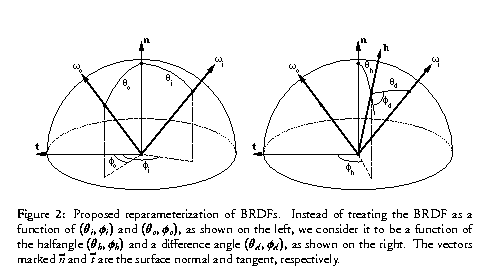
Last update: Sept. 8, 1998
Publications by on BRDF Modeling :
BibTeX references.
by Szymon Rusinkiewicz
, Stanford Computer
Graphics Lab.
1998 Eurographics
Workshop on Rendering
We describe an idea for making decomposition of Bidirectional Reflectance Distribution Functions into basis functions more efficient, by performing a change-of-variables transformation on the BRDFs. In particular, we propose a reparameterization of the BRDF as a function of the halfangle (i.e. the angle halfway between the directions of incidence and reflection) and a difference angle instead of the usual parameterization in terms of angles of incidence and reflection. Because features in common BRDFs, including specular and retroreflective peaks, are aligned with the transformed coordinate axes, the change of basis reduces storage requirements for a large class of BRDFs. We present results derived from analytic BRDFs and measured data.

Szymon Rusinkiewicz, Stanford Computer Graphics Lab
Project for CS348c, Winter 1997.
Click here for the on-line, HTML version.
Whether they are generated from theoretical models or measured, BRDFs for computer graphics need efficient representations. We examine the representations that have been proposed, including data tables, analytic models, splines, spherical harmonics, wavelets, and Zernike polynomials. This evaluation suggests that most are lacking in flexibility, compactness, or computational efficiency. We propose some approaches to improving on these methods by making greater use of the symmetry of BRDFs.
It is foreseen that the most important area of future research will be to efficiently extend BRDF representations to accomodate spatial variations.
Page created & maintained by Frederic Leymarie,
1998.
Comments, suggestions, etc., mail to: leymarie@lems.brown.edu